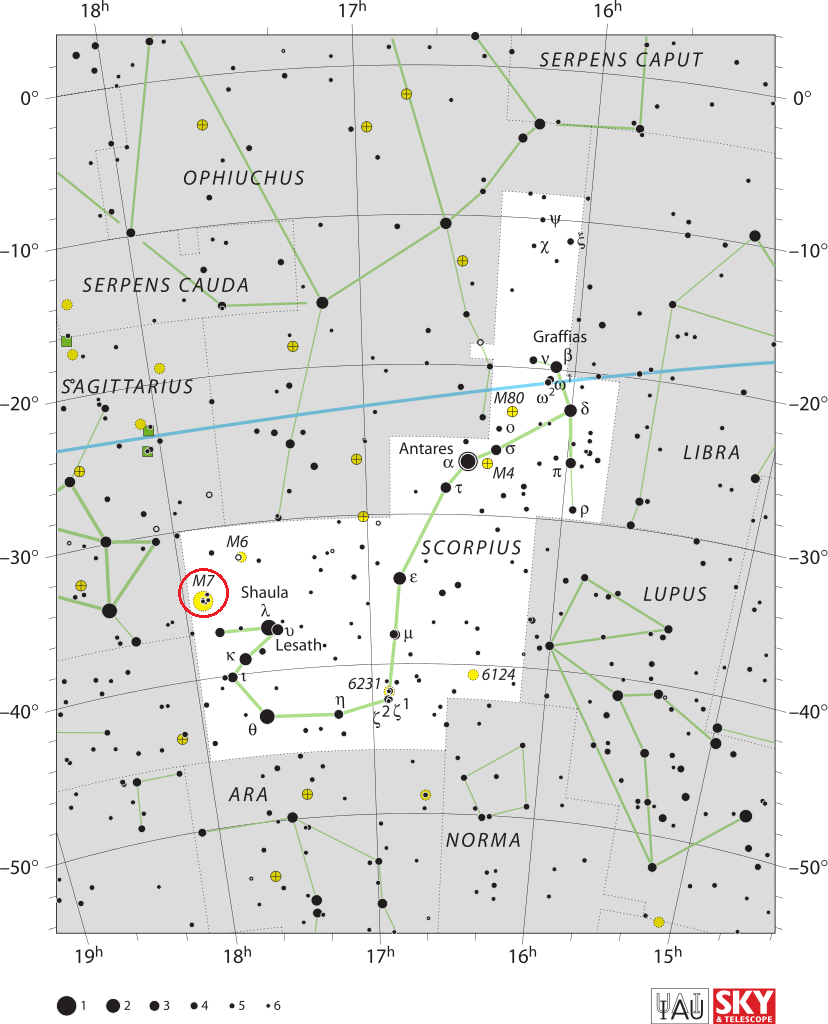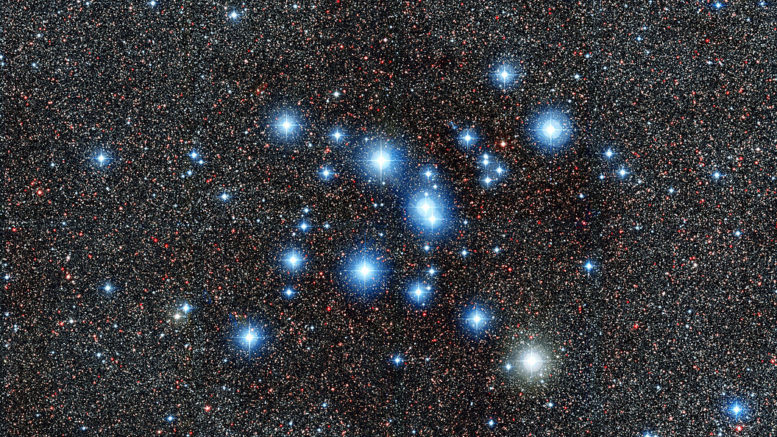One of the earliest known stars to be recoded, Messier 7, the Ptolemy Cluster is a wonderful bright open cluster to observe. Being the southernmost Messier object in the sky, M7 is very hard to
| Description | |
| Visible From Pacific Northwest | May to August |
| Best Time To Observe | July |
| Minimum Size Of Viewing Device | Naked Eye, Binoculars, or Small Telescope |
| Object Type | Open Cluster |
| Designations | Messier 7, M7, Ptolemy’s Cluster, NGC 6475, Collinder 354, Lac. II.14 |
| Right Ascension | 17h 53m 51.2s |
| Declination | -34°47’34” |
| Constellation | Scorpius |
| Apparent magnitude | 3.3 |
| Apparent dimensions | 80′ |
| Object Radius | 25 light years |
| Distance From Earth | 978.5 light years |
History
M7 is one of the most prominent open clusters in the sky, known since antiquity. It was named Ptolemy’s Cluster because it was first recorded by the Greek astronomer and mathematician Claudius Ptolemy in the 2nd century. Ptolemy listed the cluster in his Almagest as Object Number 567 and described it as a “nebula following the sting of Scorpius” in 130 AD.
Italian astronomer Giovanni Batista Hodierna counted 30 stars in the cluster before 1654. In 1678, English astronomer Edmond Halley included the cluster in his catalogue of southern stars as No. 29.
French astronomer Nicolas Louis de Lacaille observed the cluster on June 15, 1752 and listed it as Lac. II.14 in his catalogue of southern objects. He described the cluster as a “group of 15 or 20 stars very close together, in the figure of a square.”
Charles Messier included the cluster as the seventh entry in his catalogue on May 23, 1764. He described it as a “star cluster, more considerable than the preceding [Messier 6]; to the naked eye, this cluster looks like a nebulosity; it is little distant from the preceding, placed between the bow of Sagittarius & the tail of Scorpius.”
In the 19th century, M7 was accurately described as “coarsely scattered clusters of stars” by the English astrononer John Herschel.
Locating M7 In The Sky
Messier 7 is one of the few Messier Objects that is easily detectable with the naked eye. Under dark conditions, it will appear as a conspicuous patch in the sky. But amateur astronomers are to take care that they not confuse it with its dimmer, northwestern neighbor, M6. One of the easiest ways to located it is to locate the two familiar constellation asterisms of Scorpius and Sagittarius in the night sky. The bright star that represents the ‘stinger’ on the tail of the Scorpion is Lambda. Aim your binoculars three finger-widths east.

Viewing M7
Messier 7 is one of the few Messier Objects that is easily detectable with the naked eye. Under dark conditions, it will appear as a conspicuous patch in the sky. With binoculars, Messier 7’s stars will appear of varied brightness with no particular pattern, and will occupy about 1/3 the field of view in average binoculars. Those using a telescope are encouraged to use the lowest magnification because of Messier 7’s large apparent size. Because it is so bright, this open cluster is a great object on a moonlit night and larger telescopes can fully resolve its members.
Photographing M7
To image M7, one needs to use a telescope with auto guiding,
Sources And Further Reading
Our reviews of Messier Objects can be found here for those looking for a full list.

I must say, as significantly as I enjoyed reading what you had to say, I couldnt help but lose interest after a while. Its as if you had a fantastic grasp to the subject matter, but you forgot to include your readers. Perhaps you should think about this from a lot more than 1 angle. Or maybe you shouldnt generalise so much. Its better if you think about what others may have to say instead of just going for a gut reaction to the topic. Think about adjusting your personal thought process and giving others who may read this the benefit of the doubt.